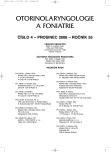The Standpoint of Surgeon on Preservation of Facial Nerve Function in Removing of Vestibular Schwannoma by Translabyrinth Approach
Authors:
J. Kovaľ 1; I. Šulla 2; S. Krempaská 1; L. Kaliarik 1; M. Almaši 1
Authors‘ workplace:
Klinika otorinolaryngológie a chirurgie hlavy a krku LF UPJŠ a FNLP, Košice
; prednosta prof. MUDr. J. Kovaľ, CSc.
Neurochirurgická klinika LF UPJŠ a FNLP, Košice
1; prednosta doc. MUDr. M. Gajdoš, CSc.
2
Published in:
Otorinolaryngol Foniatr, 55, 2006, No. 4, pp. 199-205.
Category:
Original Article
Overview
The authors describe in detail the surgical technique of dissection of a vestibular schwannoma by translabyrinth approach aimed to preserve facial nerve at the best possible functional condition. The results are evaluated in two comparable groups of patients from the point of view of the size of the tumor and the number of patients – without the use of monitoring (first 43 patients) and with the use of perioperative monitoring (the following 57 subjects from the total of 100 patients). In the group of n.VII monitoring, better functional results have been reached in all aspects from the short-term results as well as long-term outcome. However, the authors do not overestimate the importance of n.VII monitoring, since the monitored patients have been operated on at the time of more advanced surgical experience. The importance of perioperative monitoring of n.VII is considered especially in the improvement of orientation in the operation field and the comfort of the surgeon. In a certain sense the perioperative electroneuronography contributes also to the forecast of food postoperative function of n.VII (House-Brackmann I, II and III), but not for estimation of a bad function (especially House-Brackmann V, VI), when a splitting of the preserved facial nerve, which lacks the perspective of functional recovery.
Key words:
vestibular schwannoma, translabyrinth approach, facial nerve, monitoring
Labels
Audiology Paediatric ENT ENT (Otorhinolaryngology)Article was published in
Otorhinolaryngology and Phoniatrics

2006 Issue 4
Most read in this issue
- Traumatic Perforation of Eardrum
- Herpes Zoster Oticus
- Clinical Anatomy of the Epitympanum
- Possibilities of 24-hour pH-metry of Upper Esophagus in the Diagnostics of Esophageal-Pharyngeal Reflux
